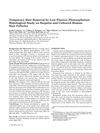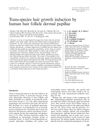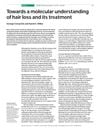TLDR Scientists found new and known long non-coding RNAs in mouse hair follicle stem cells that may be important for stem cell function and could be targets for cancer treatment.
The study utilized Illumina paired-end sequencing to profile gene expression in mouse hair follicle stem cells, focusing on long non-coding RNAs (lncRNAs). Quality control and data processing identified 2776 mRNAs and 829 lncRNAs with significant differential expression between stem and non-stem cells. Known keratinocyte stem cell genes and both known and novel lncRNAs were identified, including an antisense lncRNA near differentially expressed histone genes. Functional analysis involved genomic location, co-expression, and GO terms. The findings suggest that lncRNAs play significant roles in hair follicle stem cells and cancer, providing a dataset for potential biomarkers and treatment targets in both mice and humans.
October 2022 in “Experimental Dermatology” New technologies show promise for better hair regeneration and treatments.
April 2017 in “The journal of investigative dermatology/Journal of investigative dermatology” Researchers developed a method to grow human hair follicles using 3D-printed skin models and modified cells.
 134 citations
,
September 2008 in “Lasers in surgery and medicine”
134 citations
,
September 2008 in “Lasers in surgery and medicine” Low fluence photoepilation temporarily removes hair by targeting the hair follicle's pigmented area without severe damage.
276 citations
,
January 2005 in “International review of cytology” More research is needed to understand how hair keratins work and their role in hair disorders.
 66 citations
,
August 2001 in “Experimental Dermatology”
66 citations
,
August 2001 in “Experimental Dermatology” Human hair follicle cells can grow hair when put into mouse skin if they stay in contact with mouse cells.
 236 citations
,
July 2001 in “Trends in Molecular Medicine”
236 citations
,
July 2001 in “Trends in Molecular Medicine” Future hair loss treatments should aim to extend hair growth, reactivate resting follicles, reverse shrinkage, and possibly create new follicles, with gene therapy showing promise.
133 citations
,
July 1994 in “Journal of Dermatological Science” Human hair growth can be influenced by certain growth factors and has specific metabolic needs.


